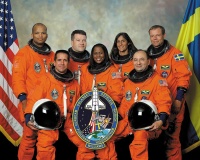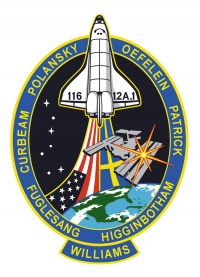STS-116
From The Space Library
 | |
| Organization | National Aeronautics and Space Administration (UnitedStates) |
|---|---|
| Mission type | Human Crew |
| Launch date | December 10, 2006 |
| Launch vehicle | Space Shuttle |
| Launch site | Cape Canaveral, United States |
| COSPAR ID | 2006-055A |
| Inclination | 51.6 degrees |
| Experiments | Here |
| Alternate Names | 29647 |
| Additional Information | Here |
| Data Collection | Here |
| Payload Mass Up | 16202.31 kg |
| Payload Mass Down | 1684.09 kg |
| Orbiter | Discovery |
| Lift Off Mass | 2,054,697.27 kg |
| Orbiter Weight at Liftoff | 120,579.55 kg |
| Orbiter Weight at Landing | 102,468.64 kg |
| Landed | 5:32 p.m. EDT, concrete runway 15, Kennedy Space Center, Fla. |
| Orbits of Earth | 204 |
| Orbital Altitude | Approximately 185 nautical miles |
Contents |
[edit] Crew
- Commander: Mark L. Polansky
- Pilot: William A. Oefelein
- Payload Commander:
- Mission Specialist 1: Robert L. Curbeam Jr.
- Mission Specialist 2: Joan E. Higginbotham
- Mission Specialist 3: Nicholas J.M. Patrick
- Mission Specialist 4: Christer Fuglesang, European Space Agency (ESA)
- Mission Specialist 5:
- Payload Specialist 1:
- Payload Specialist 2:
ISS/Mir Crew Transport
- Sunita L. Williams - up only Thomas Reiter - down only
[edit] Mission
STS 116 is an American (NASA) shuttle spacecraft that was launched from Cape Canaveral at 01:47 UT on 10 December 2006. It carried a crew of seven (five Americans and two Europeans) to the International Space Station (ISS) to do some major repairs and installations. It docked with the ISS on 11 December. The crew disconnected the power lines leading to what has been a temporary source (since 1998) and connected them to the recently installed solar panels. The crew overcame problems in rolling back the older panels after three spacewalks, totaling several hours. They also made a spacewalk to install a two-tonne truss (P5) to enable additions to the station. The 13-day mission ended when the shuttle landed back in Cape Canaveral at 22:32 UT on 22 December. One of the seven members of the crew stayed on the ISS, replacing another astronaut who had stayed there for six months.
[edit] EVA
Extravehicular Activity (EVA) conducted by Robert Curbeam, Christer Fuglesang, and Sunita Williams during four spacewalks for a total of 25 hours, 45 minutes. EVA 1, 6 hours, 36 minutes; Curbeam and Fuglesang attached the two-ton P5 segment, which had been unberthed the day before using the shuttle's robotic arm to remove it from the orbiter's payload bay and hand it off to the station arm. Guided by Curbeam and Fuglesang, Joan Higginbotham maneuvered the P5 into place. EVA 2, 5 hours, 0 minute; Curbeam and Fuglesang reconfigured two of the station's four power channels, channels 2 and 3. EVA 3, 7 hours, 31 minutes; Curbeam and Sunita Williams reconfigured the station's power channels 1 and 4, setting the stage for future installation of additional solar arrays and science modules, including those of international partners. EVA 4, 6 hours, 38 minutes; the P6 solar array wing had been extended in space for six years. The array panels would not fully retract because of a snagged guide wire, necessitating the addition of the fourth spacewalk to free the partially retracted solar array so it would fully fold. Curbeam and Fuglesang guided the P6 solar array wing inside its blanket box. Subsequently, the Solar Alpha Rotary Joint was powered up, enabling it to begin turning the P4 truss solar array wings, which had been installed in Sept. 2006, allowing the arrays to track the sun as it rises and sets with each station orbit.
[edit] Payload
ISS Assembly Flight 12A.1; ITS P5, third port truss segment; SPACEHAB single cargo module; Integrated Cargo Carrier (ICC); Microelectromechanical System-Based PICOSAT Inspector (MEPSI) microsatellite; Radar Fence Transponder (RAFT) microsatellite; Atmospheric Neutral Density Experiment (ANDE) microsatellite; ISS crew exchange
[edit] Books about the Space Shuttle Program
Buy This Book Click here |
Buy This Book here |
Buy This Book Click here |
Buy This Book Click here |





